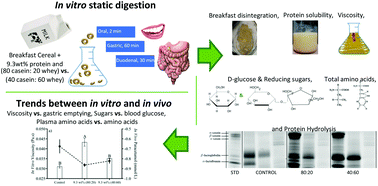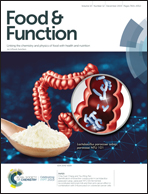Correlating in vitro digestion viscosities and bioaccessible nutrients of milks containing enhanced protein concentration and normal or modified protein ratio to human trials
Abstract
This work compared in vitro and in vivo digestion of breakfast cereal with milks containing high protein concentration (9.3 wt%) and the normal protein ratio (80 casein : 20 whey) or a modified ratio (40 casein : 60 whey) and with a water-permeate control. The in vivo study indicated that high protein concentration and modified ratio in milks delays the postprandial appearance of blood glucose (BG) and amino acids due to delayed gastric emptying and hormonal responses. However, the role of viscosity and/or protein structure during digestion was not examined. Therefore, milks and the control were digested in vitro (oral (O, 2 min), gastric (G, 62 min) and duodenal (D, 92 min)) to determine viscosity, particle disintegration, protein solubility and hydrolysis, and the bioaccessibilities of sugars and total amino acids (TAA). The normal ratio (80 : 20) treatment demonstrated higher structural viscosity during digestion (P < 0.05) due to the formation of casein aggregates and interaction with cereal and greater TAA (mg per g protein of undigested breakfast) caused by gastric hydrolysis (DH%; P = 0.01). Overall, there were no treatment differences for disintegration, solubility and D-glucose. Protein-containing treatments inhibited amylolysis and lowered reducing sugars (mg g−1 available carbohydrates of undigested breakfast) compared to the control. Similar trends were observed between higher viscosity (Pa s) during gastric stage and slower in vivo gastric emptying (paracetamol, mmol L−1). Also, protein treatments inhibited amylolysis and lowered reducing sugar (mg g−1 of carbohydrates) and may have contributed to lowered BG (mmol L−1 g−1 of carbohydrates) after the duodenal phase. However, increased viscosity, elicited by higher proportions of casein, did not inhibit starch hydrolysis and appearance of BG. In vitro systems provide similar trends in biomarkers to in vivo studies and can be used to answer specific physiological questions.



 Please wait while we load your content...
Please wait while we load your content...